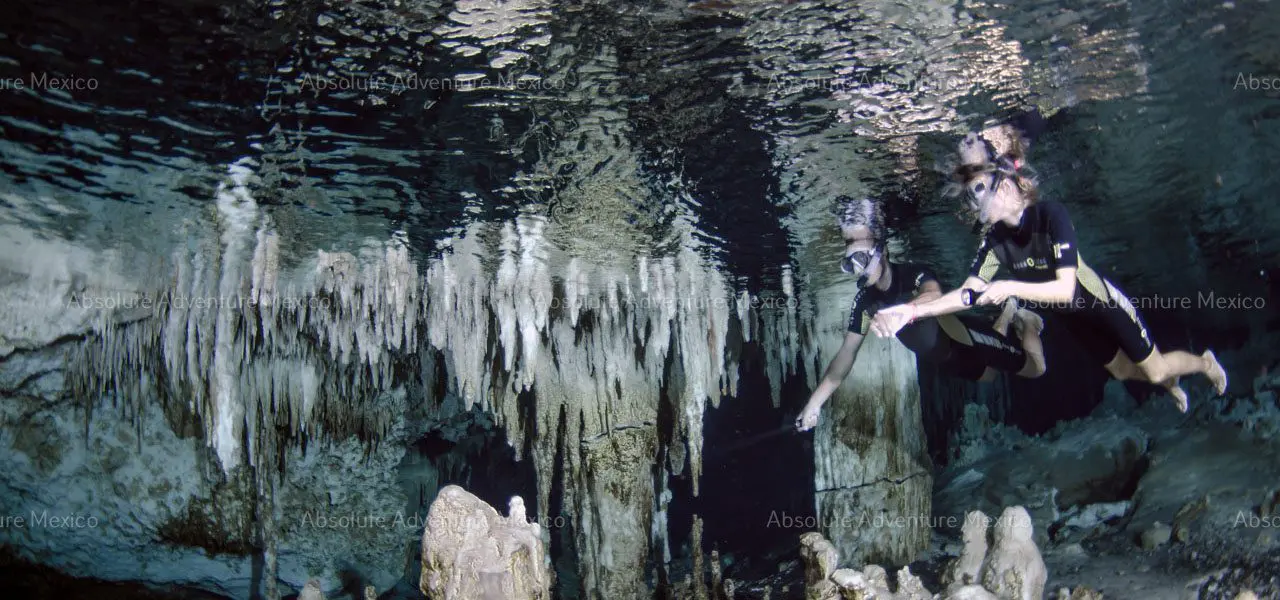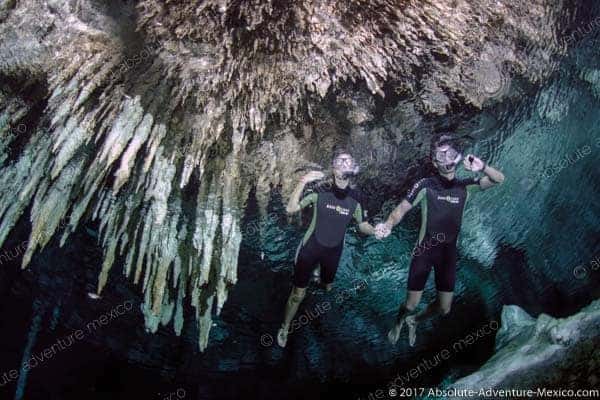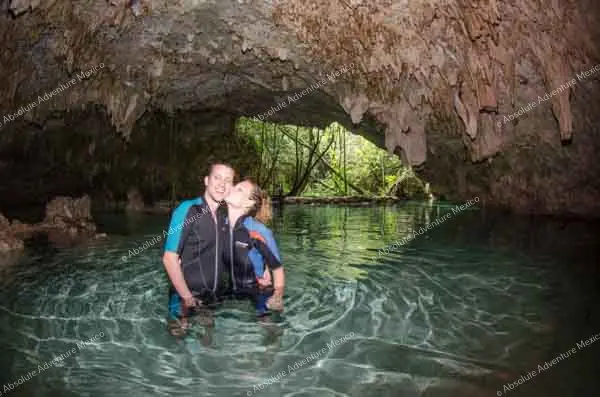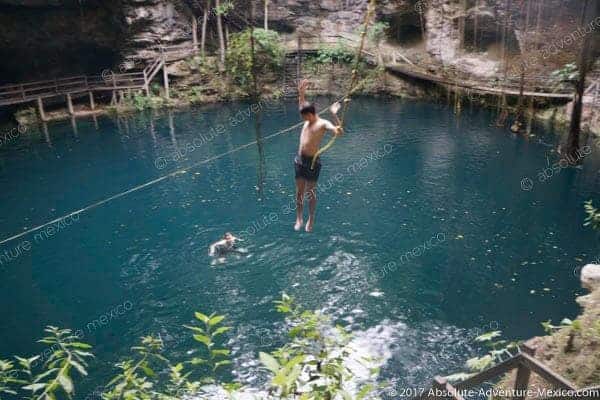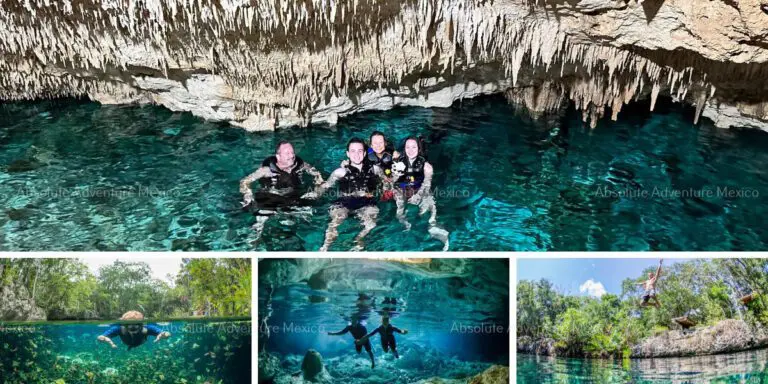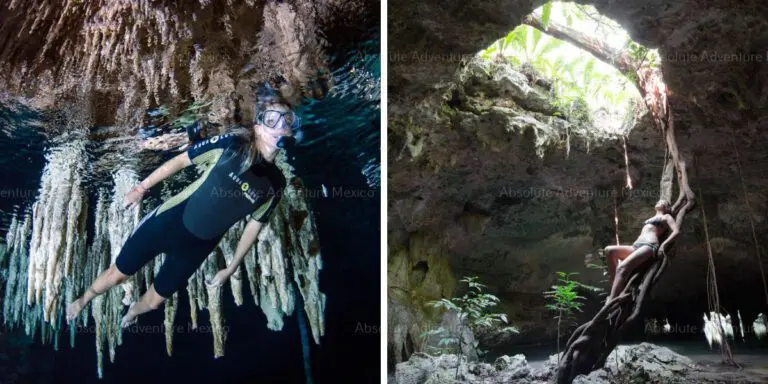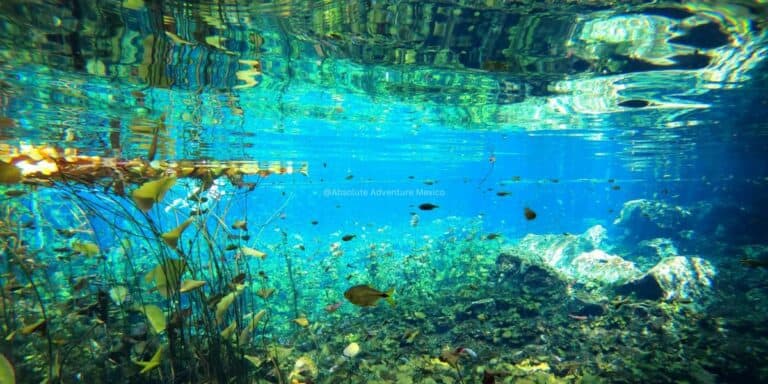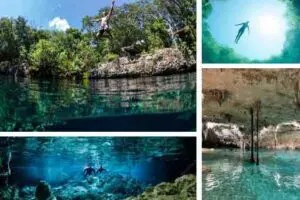Snorkeling in Cenote, a unique experience
Cenotes (say-‘NO-tays) are an underground system of stunning, water-filled caves and caverns that formed when rainwater, falling over millennia, wore away the limestone and filled the caves with water. As the roofs of these caves collapsed, underwater sinkholes and caverns formed. The Mayans called them cenotes.
Swimming or snorkeling in a cenote offers a truly unique experience found only in Mexico. These natural sinkholes provide an opportunity to immerse yourself in the beauty of fresh water snorkeling amidst the lush jungle surroundings. It’s a tranquil and relaxing experience, far away from the possible hustle and bustle of the ocean.
A peaceful experience
Cenotes are particularly suitable for snorkeling beginners due to their calm and quiet waters. There are no currents or waves to contend with, making it easier to navigate and enjoy the experience. The water is incredibly clear, providing excellent visibility (often exceeding 50 meters (150 ft)), so you need not worry about not seeing what’s below you.
A Beautiful Scenery
What sets cenote snorkeling apart from ocean snorkeling is the magical ambiance created by the sunlight filtering through the water, creating mesmerizing effects. The reflection of jungle trees and plants in the crystal clear water adds an extra touch of enchantment. While you may encounter fewer fish compared to the ocean, there is a wealth of other wildlife to admire, such as tropical birds soaring above and the bats flitting by.
No Matter What! Lets go to the cenotes!
One of the remarkable advantages of cenote snorkeling is the flexibility it offers. Regardless of the time of year, cenotes maintain a consistent temperature, ensuring you can partake in the activity whenever you please. They are open all days of the year, unaffected by wind or waves. Even if it happens to rain, you’re still protected as you swim within the cave, adding a sense of adventure to your experience.
In summary, swimming or snorkeling in a cenote is an unparalleled adventure. With its exclusivity, serene atmosphere, ideal conditions for beginners, unique visual elements, and year-round accessibility, it guarantees a remarkable and unforgettable encounter with nature.
Don’t hesitate, snorkeling in cenote should be on your top 3 of the things to do during your stay!
Cenotes FAQ
Consult our FAQ about cenotes! Here, you’ll find all the essential information you need to prepare for your next cenote trip, from understanding what cenotes are to knowing what to bring and expect during your visit.
What are the different types of cenotes?
There are primarily two main types of cenotes:
Open air cenotes: These cenotes resemble natural pools in the jungle. They are characterized by their exposed surface and can offer a refreshing and picturesque swimming experience.
Cave cenotes: These cenotes are located underground within cave systems. They provide the opportunity to swim and dive in underground rivers, surrounded by stunning rock formations. Exploring cave cenotes offers a unique and adventurous experience for visitors.
What can we see in cenotes?
In cenotes, you can witness stunning formations of stalactites and stalagmites, spot bats in cave cenotes, observe small freshwater fish (more common in open-air cenotes), and if you’re lucky, even encounter small turtles. You’ll also find many birds around and might catch a glimpse of iguanas.
How deep are the cenotes?
Cenotes can vary in depth, ranging from just a few feet to hundreds of feet.
Is it safe to swim in cenotes, will I feel claustrophobic?
Yes, it is safe, especially when wearing a mandatory life vest, which is required in most cenotes. As cenotes contain fresh water, which makes you less buoyant, we still recommend non-experienced swimmers to wear a life vest, even when it is not mandatory.
For those concerned about feeling claustrophobic, there is no need to worry. Cenotes are expansive caves with ample space, and they are equipped with artificial lighting. Rest assured that visiting cenotes is completely safe and designed to provide a comfortable experience for all.
Can I dive into the cenotes?
Swimming and snorkeling in cenotes is easy and accessible to anyone.
However, free diving is only allowed with certified free diving guides and organizations.
Scuba diving in cenotes is restricted to certified scuba divers accompanied by a certified Cenote diving guide.
What is the water temperature of the cenotes?
The water temperature in cenotes remains around 74-75°F (24-25°C) throughout the year, which is not considered cold. However, compared to the outside temperature, the water may feel chilly. Some tour operators provide wetsuits or shorty suits to enhance your experience and allow you to enjoy the cenote for longer periods without feeling cold.
What are the best cenotes to visit?
With thousands of cenotes in the Yucatan Peninsula, we have compiled a list of the best cenotes for you to visit. Check out our recommendations!
Is it necessary to have a guide when visiting a cenote?
While a guide is not mandatory in most cenotes, there are certain cenotes where having a guide is required to access specific areas for safety and conservation purposes.
Moreover, choosing to have a guide can offer you numerous advantages during your cenote experience. To learn more about the benefits, we recommend reading our detailed article on this topic and the advantages of a Cenotes private tour.
What should I bring on my cenote trip?
Here’s a list of recommended items to bring:
- Swim suit and towels
- Phone with a waterproof case for capturing pictures
- Cameras, underwater cameras, or GoPro (Note that some cenotes may charge a fee for taking “professional” photos)
- Mosquito repellent and sunblock (apply after snorkeling, as applying it before swimming/snorkeling can pollute the water)
- Water shoes (not mandatory but can provide extra comfort)
- Mask and snorkel (can be rented on-site or provided by most cenote tour operators)
What items are not allowed to be brought?
- It is not permitted to bring food and drinks.
- Drones are not allowed.
Can I visit cenotes when it is raining?
Absolutely! In fact, visiting cenotes during rain can be a unique and wonderful experience. We recommend opting for cave cenotes in such situations, as they provide ample shelter from the rain. While open-air cenotes may have reduced sunlight reflections, both types of cenotes are completely safe to visit during rainfall. In fact, exploring cenotes on a rainy day can be one of the best activities to enjoy!

